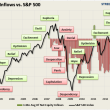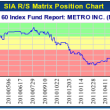July 26, 2013
by Liz Ann Sonders, Senior Vice President, Chief Investment Strategist, Charles Schwab & Co., Inc.
and Brad Sorensen, CFA, Director of Market and Sector Analysis, Schwab Center for Financial Research
and Michelle Gibley, CFA, Director of International Research, Schwab Center for Financial Research
Key Points
- Equities have drifted higher during a decent earnings season with few surprises, while yields have calmed and volatility has plunged. Typical lackluster summer action may prevail for the next month, but action is likely to heat up as the weather begins to cool.
- Washington is relatively quiet on the financial front but rumbles are beginning to build that may start to reverberate through the market. Meanwhile, Fed Chair Bernanke's likely final Congressional testimony reiterated the Central Bank's intention to stay quite accommodative.
- Despite some flare-ups in Europe, a bottom does appear to be forming, providing opportunity for some investors. Likewise, we're encouraged by developments in Japan, although China's trajectory remains concerning.
After some hair-raising summers over the past several years, calm, almost boring, trading has settled in on Wall Street—at least for the time being. Second quarter earning season has passed its peak, and results have largely been better than expected on the bottom line, while top-line results have been less impressive, but good enough for the drifting stock market to maintain an upward bias. Perhaps the most consequential general takeaway to this point in the earnings parade has been the pretty clear positive view of the domestic side of the ledger, while international results have largely disappointed. Commentary on the future indicates that most executive believe that trend will continue at least over the next couple of quarters.
Calming Down…For Now
Source: FactSet, Chicago Board Options Exchange. As of July 24, 2013.
We have had a domestic bias for some time now, and we believe the US continues to be an attractive place for investors. In the near-term, more muted sideways actions seems likely to us, with the next catalyst not readily appearing on the horizon. Of course, events both here and around the world can change at a moment's notice, which is why we continue to believe that a diversified portfolio consistent with your risk tolerance is key to achieving investment goals. And this period of calm provides a good opportunity to take a step back and review your current stance.
Economy continues steady, but modest, growth
Looking a bit beyond the near term, toward the fall when things seem likely to pick up again, we believe factors are lining up for a continued uptrend for stocks, while yields seem likely to ease their way higher as well. Although the gains in equities seen in the first half of the year shouldn't be expected in the second half, we remain positive on the potential for further upside.
Economic growth continues to show steady, if not robust, growth. Manufacturing is showing signs of resuming expansion after a bit of a summer soft spot, as the Empire Manufacturing Index rose to 9.5 from 7.8 and the Philly Fed Index jumped to 19.8 from 12.5. Additionally, industrial production rose by 0.3%, indicating further support for the manufacturing sector.
However, there has been a bit of concern growing around the all-important US consumer as retail sales ex-autos and gas fell by 0.1% in June. Meanwhile, oil prices have moved higher, potentially putting further pressure on already burdened pocketbooks. However, we've learned that it's often detrimental to underestimate the resilience of the US consumer and believe the retail sales number was more of a blip than the start of a trend. Prices at the pump seem likely to pull back over the coming months as the summer driving season ends and oil prices reverse. We believe a reversal is in the cards due to the factors that caused the recent rise being largely short-term in nature. Concern over the Egyptian conflict and its impact on the vital Suez Canal seem to be overblown and the crisis is fading, while some distortions within the crude complex have largely corrected, leading us to believe a retreat is in order.
Meanwhile, auto sales and housing continue to support consumer sentiment, despite the recent rise in rates. We've seen some softness in mortgage applications, largely on the refinancing side, but homebuilders remain optimistic as the National Association of Homebuilders (NAHB) latest survey of conditions in the housing market rose to 57 from 51, which is highest reading since January of 2006.
Homebuilder sentiment improving
Source: FactSet, National Assoc. of Home Builders. As of July 24, 2013.
And although the recent housing starts number showed a disappointing 9.9% decline, the vast majority of that was due to the volatile multi-family component dropping 20%, while the internals of the building permit number showed the headline 7.5% drop being largely offset by a 0.6% gain in single family permits—indicating further growth in home construction.
Finally, and perhaps most importantly, the labor market continues to show signs of improvement. Last month's labor report showed nice gains in employment, although the unemployment rate remains elevated at 7.6%. Most encouragingly, the forward-looking initial jobless claim report showed a sharp drop recently and have remain in the range of continued labor improvement for some time.
Fed message consistent, while calm in Congress may be short lived
The market seems to have become more comfortable with the idea that the Federal Reserve could begin tapering its asset purchases later this year, most likely at the September meeting at the earliest in our view. Helping that comfort level has been a more consistent message from various members, and reiterated by Chairman Bernanke in what could have been his last testimony before Congress. He again noted that the Committee has no preset schedule to pare purchases, and that the incoming data, combined with fiscal developments, will determine future action or inaction. He did note that inflation at the core level remain below where they would like to see it (core CPI is up only 1.6% year-over-year). This could result in them holding purchases constant longer than expected in an effort to avoid a deflation scenario that unnerves the Chairman. The end result to us is that the Fed will remain ultra-accommodative until the economic data is strong enough in their view to start to remove support—a pretty good environment for stocks in our view.
While we don't expect any action at the Fed's next meeting on July 30-31, down the street, Congressional rhetoric seems to be building toward fall showdowns. We don't think we'll experience the brinksmanship politics we've had over the past several years. But we do have a new debt ceiling debate coming in the next month or two, the Affordable Care Act has been troubled and calls for repeal are likely to increase following reversals by major US labor unions as they withdrew their support for the law, tax and spending arguments are likely to heat up again, and regulatory issues remain contentious. Much of this is typical Washington bickering, which is largely ignored by Wall Street, but investors should be monitoring the developments in DC as issues likely will spill into the private sector, impacting markets and potentially investing decisions.
Europe: despite debt issues, some progress
Across the pond, monetary policy in Europe looks likely to stay easy with the European Central Bank (ECB) giving "forward guidance" in July, committing to an easy stance for "as long as necessary" and the Bank of England (BoE) signaling a potential move to forward guidance in August.
Meanwhile, economic growth in Europe is no longer deteriorating at the same pace, and may actually be bottoming. The eurozone Manufacturing PMI Index, rose to 50.1 in July, above the 50 level that denotes expansion for the first time in two years. Moreover, the eurozone Composite PMI Index—which includes both manufacturing and services—improved to 50.4, the first reading above 50 since January 2012. Additionally, the eurozone leading index has been improving since September.
Eurozone may be bottoming
Source: FactSet, OECD. As of July 24, 2013.
However, the eurozone debt crisis remains a risk, as evidenced by political concerns in Portugal and Spain, and Greece's continued woes. Positively though, peripheral government bond yields have been fairly quiet, with the ECB's conditional bond purchase program containing downside risks. We believe volatility in eurozone stocks is likely to be a buying opportunity, as a fair amount of bad news has likely already been priced into eurozone stocks, where earnings and valuations for eurozone stocks are depressed. Note that a rising US dollar relative to the euro could reduce returns.
Japan—now comes the hard part
Companies in Japan are cautious, despite the economic recovery. According to Nomura, large companies have estimated that earnings will rise about 25% in the June quarter from a year ago, but have used an exchange rate of 90 US dollars to the yen, while the average last quarter was 99, which could raise profit growth nearer to 50%. Business caution may be partly because that while a weaker yen boosts export revenues, volumes have not recovered by the same magnitude, with little evidence exporters are using the weaker yen to boost market share by cutting prices.
Regardless, business sentiment is slowly improving. Large manufacturers turned positive in the second quarter Tankan survey and boosted their capital spending plans. Japan's corporate sector has accumulated a massive pile of cash, at 225 trillion yen ($2.27 trillion), greater than the $1.8 trillion in the U.S., despite the US economy being 2.5 times bigger than Japan's. The hope is that eradicating deflation will make holding cash less attractive and unleash corporate investment, and possibly boost cash buybacks or dividends. Companies could also begin to increase wages.
We believe structural reforms are needed to sustain the economic recovery, the most difficult of Abe's "three arrows" to revive Japan. Parliamentary elections this month gave Prime Minister Shinzo Abe's coalition a majority in both houses, clearing the way to begin reforms to:
- Reduce labor regulations that limit business flexibility and distort hiring practices.
- Increase participation by women in the labor force to boost output.
- Reform corporate taxes, currently the second-highest effective rate in the OECD at 35.6%, just below the 39.1% in the U.S., and above Singapore's 17.0% and China's 25.0%.
- Raise the consumption tax to reduce the fiscal deficit. Abe's administration said the increase is conditional on economic strength in the 2Q GDP report issued in August and revised in September.
- Join the Trans Pacific Partnership (TPP) international free-trade agreement, which could enhance access for Japanese companies.
- Reform the agricultural sector as protections for small farmers result in high food prices.
Markets want Abe to tackle reforms to prove he is serious about fiscal consolidation. Positively, the yields on Japanese government bonds (JGBs) have been fairly flat since May, despite global bond market volatility. We believe Japanese stocks could move sideways near term, but the intermediate term outlook is positive for patient and disciplined investors. A weak yen relative to a strong US dollar would reduce returns, and investors may want to consider hedging currency exposure.
China's tricky balance: growth versus reform
We've been noting that China's growth would slow due to our concern about the sustainability of China's debt-fueled, construction-led economic model. Indeed, economic growth continues to slip, indicated by the HSBC preliminary manufacturing reading dropping to 47.7 in July, the lowest since August 2012, and the employment subcomponent falling to 47.3, the lowest since March 2009. The reality is that each marginal dollar of debt is producing less in economic return.
More debt but less economic return in China
Source: FactSet, Bloomberg, People's Bank of China, National Bureau of Statistics. As of July 24, 2013.
So far, policymakers have tried cracking down on the shadow banking sector, government extravagance, and property speculation to reduce excesses and imbalances in the economy, enduring short-term economic pain for longer-term gain. However, with concerns about whether the government could stop growth from falling further and after much confusion, it sounds as though 7.0% is the "bottom line" growth the government will defend. While announcing that no large-scale stimulus measures would be used this year, small measures have been unveiled but sound like policies of the old model: railway investment, require local governments to speed up their yearly spending, and measures to help exporters. Ultimately, the government's room to maneuver appears limited. In fact, stocks may not necessarily react positively if the government switched to short-term gain for longer-term pain.
We view removing the floor for lending rates as a symbolic, if incomplete, part of reform, but it is unlikely to have much near term impact. Only 11% of loans were priced below the benchmark in 1Q according to the central bank, indicating little benefit from removing the floor. With shadow lending likely to contract, a major question is how the economy performs when this support is withdrawn, and borrowers in the shadow banking system won't be able to access the new lower rates. Additionally, the deposit rate ceiling remains and is a factor for depositors resorting to the shadow banking system in search of higher returns.
We believe China-related investments, including emerging market stocks and commodities, will encounter difficulty until investors have confidence about where and how China's economy stabilizes. Read more Avoid China—Subprime-Like Bubble Brewing, as well as related topics at www.schwab.com/oninternational.
So what?
Don't get lulled into drifting along with the markets. Circumstances can change rapidly and the calm periods are the times to prepare for the inevitable storms. Within a diversified portfolio, we continue to like the US equity markets and are warming to Europe and Japan. It continues to appear that China's recent struggles aren't over and emerging markets in general are sharing the burden and we suggest approaching investments in those areas with caution.
Important Disclosures
Manufacturing Purchasing Managers Index (PMI) is an indicator of the economic health of the manufacturing sector. The PMI index includes the major indicators of: new orders, inventory levels, production, supplier deliveries and the employment environment.
HSBC China Purchasing Managers Index (PMI)is an indicator, created in conjunction with Markit, of the economic health of the Chinese manufacturing sector. The PMI index includes the major indicators of: new orders, inventory levels, production, supplier deliveries and the employment environment.
Yen per US Dollar Spot Rate is the immediate settlement price of what one US dollar will purchase of Japanese yen on the foreign exchange (FOREX) market.
Real Gross Domestic Product (GDP) is an inflation-adjusted measure that reflects the value of all goods and services produced in a given year, expressed in base-year prices.
The Empire State Index is a regional, seasonally-adjusted index published by the Federal Reserve Bank of New York distributed to roughly 175 manufacturing executives and asks questions intended to gauge both the current sentiment of the executives and their six-month outlook on the sector.
The Philadelphia Federal Index is an index that is published by the Philadelphia Federal Reserve Bank and is constructed from a survey of participants who voluntarily answer questions regarding the direction of change in their overall business activities. The survey is a measure of regional manufacturing growth.
The National Association of Homebuilders (NAHB)—Wells Fargo Housing Market Index (HMI) is based on a monthly survey of NAHB members designed to measure homebuilder sentiment in the single-family housing market. The survey asks respondents to rate market conditions for the sale of new homes at the present time and in the next 6 months as well as the traffic of prospective buyers of new homes. It is a weighted average of separate diffusion indices for these three key single-family series.
Leading Economic Index is an index that is a composite average of leading indicators and is designed to signal peaks and troughs in the business cycle.
Housing Starts and Building Permits report is data compiled by the U.S. Census Bureau that reports the number of new residential construction projects that have begun during any particular month, while permits is the finalized number of the total monthly building permits on the 18th work day of every month.
The Chicago Board of Exchange (CBOE) Volatility Index (VIX) is an index which provides a general indication on the expected level of implied volatility in the US market over the next 30 days.
Indexes are unmanaged, do not incur fees or expenses and cannot be invested in directly.
Past performance is no guarantee of future results.
Investing in sectors may involve a greater degree of risk than investments with broader diversification.
International investments are subject to additional risks such as currency fluctuations, political instability and the potential for illiquid markets. Investing in emerging markets can accentuate these risks.
The information provided here is for general informational purposes only and should not be considered an individualized recommendation or personalized investment advice. The investment strategies mentioned here may not be suitable for everyone. Each investor needs to review an investment strategy for his or her own particular situation before making any investment decision.
All expressions of opinion are subject to change without notice in reaction to shifting market conditions. Data contained herein from third party providers is obtained from what are considered reliable sources. However, its accuracy, completeness or reliability cannot be guaranteed.
Examples provided are for illustrative purposes only and not intended to be reflective of results you can expect to achieve.
The Schwab Center for Financial Research is a division of Charles Schwab & Co., Inc.











